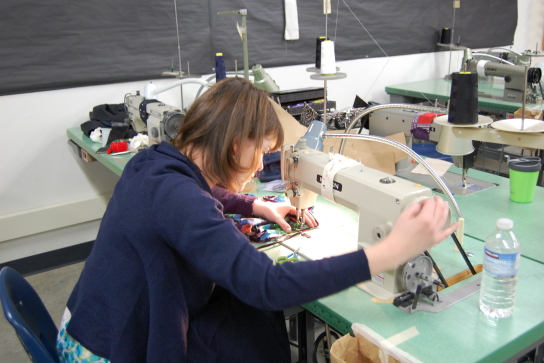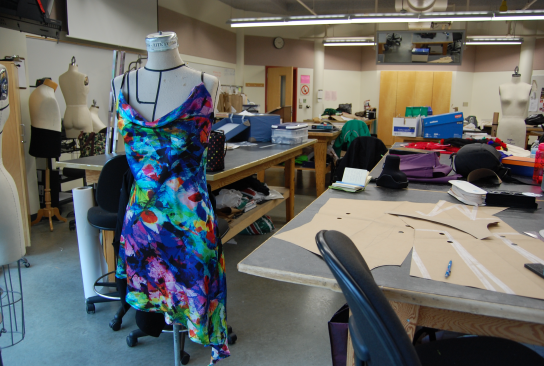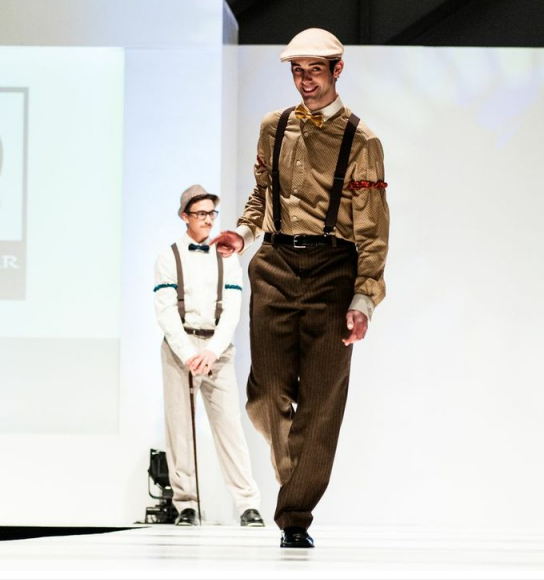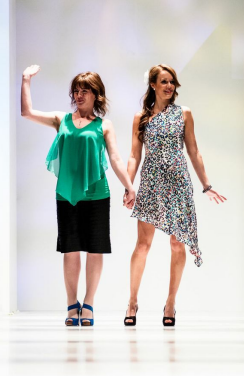By Griffy Vigneron (The Cascade) – Email
Print Edition: May 22, 2013
Absolute Style is an annual culmination of countless hours of work on the part of UFV’s Fashion Design students. It is especially monumental to the graduating students of the fashion program as their own version of a convocation ceremony.
With hours spent on the design and creation of garments over the course of the two-year program, the fashion show is not simply a glamorous send-off. There is personal meaning and accomplishment behind it – the chance for the students to finally have their hard work and creative direction brought beautifully and vibrantly to life.
 The energy and glamour of the runway
The energy and glamour of the runway
With seemingly effortless grace, the show’s models pulled off each of their designer’s styles. In perfect time, their flowing movements captured the audience’s imagination – safari prints, Russian chic, exotic Thai and the simple elegance of modern minimalism.
Hip, catchy music followed the models down the runway, matching their steps, beat for beat – flitting amidst their twists and turns. Amongst the class of the outfits, the music captured the energy of the graduates. With completion grasped and cutting edge designs released on the world, the music swept up the audience in the moment.
It was all with good reason. The fashion show is an exciting place, an exciting time for the students.
In its glamour and glory, it was easy for the show’s viewers to forget the hard work, to be whisked away in the dance of designs. After watching the students work for several weeks, as I had, it seemed too simple. It was too easy to forget the meaning behind the beautiful outfits.
And then, with one of the graduating students’ collections, the melodic voice of Lana Del Rey floated through the collections elegant dresses. It stood out among the upbeat melodies.
“Will you still love me when I’m no longer young and beautiful/ Will you still love me when I got nothing but my aching soul…”
Eerie and magical, it spoke past the surface, past the visual front.
The voice cried for recognition beyond visuals, beyond elegance and class. It wanted to be loved for who and what it was. And I felt it spoke not simply to the surface frivolity of fashion, but to the soul of each design – the work and inspiration behind it all.
Design: choices and inspirations
It can be surprisingly hard to see inspiration in a fashion class hard at work, especially when they’ve only got a few weeks left to complete the garments for their graduate collections. In one room cut patterns were strewn over the tables. In another, mechanical whirring could be heard from sewing machines. Students were so busy trying to complete things inspiration seemed to be the last thing on their mind.
In the last semester of the two-year fashion diploma program, each student is required to design a collection of clothing, which they will eventually present to a panel of judges. Out of 12 garments designed for the collections, three outfits are chosen for actual creation.
While the creation is mainly technical and hands-on work, it is the initial garment designs that began with a creative idea.
Inspirations varied from momentary light-bulb moments to more profound personal attachments.
Well-dressed and artsy, Matthew Ganzales sported a t-shirt and a pair of dress pants with suspenders thrown over the top. He looked a lot like his designs, which he explained were inspired by his recent viewings of the movie **Snatch.
“I love the British gangster ‘80s look, like layering plaids and prints together, to create like this kind of semi-formal idea,” Gonzales explained. He described how his designs could be classified with an Ivy League dandy idea behind them.
Bitty Berlinghoff is cheery, quirky and energetic. Her inspiration had a deeper story behind it, and held a specific meaning to her personally. Every summer she travels to Thailand to work with children in an orphanage. In an effort to be cool, she said the children often mix more modern North American hand-me-downs with their less “cool” but traditional Thai clothing.
About her collection’s look, Berlinghoff said, “It’s kind of street-inspired as well as Thai-inspired.”
While in Thailand she also collected snippets of traditional Thai fabrics that were hand-embroidered by the women there. She incorporated them into her designs.
“The fabrics are kind of like a badge of their history,” she said. “It shows what they come from, and where they’re going.”
Friendly and bubbly, Alysen Cox’s designs are as bright and vibrant as her personality. Jungle-themed and pushy, they involved some very creative uses of textiles. In one design, zebra print flashes daringly from the underside of a wide frilly dress.
“My design was inspired by the jungle,” Cox explained. But it wasn’t how she started. “I think I [initially] got an inspiration from one picture that I saw of a leather fringe on a jacket. I was like, ‘that’s really cool.’ I wanted that at the very beginning but then [the instructors] said ‘no’ so I had to come up with a different idea.”
The instructors have a say over what the students finally decide on. Two different fashion line ideas need to be pitched to the instructors before a decision is made.
“I had one as my jungle theme and one … was more beachy. They just asked [me] which one would [I] prefer, and I said jungle,” Cox explained.
Of course it doesn’t end there. Inspiration is simply the beginning of lengthy journey of work. Designing something is one thing, getting it to work can often be another.
“The designer has such a crazy idea,” Cox said, “but then actually sewing the garment is a whole different story … We have our crazy ideas, and then [our instructor’s] like ‘no, this is how it really goes.’”
Garment construction and alterations
Fashion students were hard at work completing their designs. Papers laid about from pattern drafting and a student fussed over a dress pinned to a mannequin. Chatter swept the room sporadically, but there was a heaviness to the air. It’s not a depressed sort of heaviness mind you, more of a focused intensity.
Inspiration had passed, now students just wanted to get the work done. Even though they were working hard, many of them would be at the school late. And not 5 p.m. late, but 11 p.m. late. According to Berlinghoff and fellow fashion student Marlie Reines, this was a normal occurrence in a five-day or more week.
Garments first start out on the drafting table. Patterns must be drafted first, which can be difficult.
“It’s hard to plan for fit when you’re using paper,” Raines said. “Paper to fabric changes and then the fabric to human changes.”
Raines was working on a ballerina-themed collection. While she’s not dedicated to fashion, she’s dedicated to completing the program. While more than half of the students in the program have already dropped out, she refused to give up and buckle under the workload. Raines wanted a sense of completion, and continued to work hard for it.
As long as students keep on top of their garment construction, they can keep up. Formal class times help out for this. On Tuesdays and Thursdays, instructors were in for several hours to help students in any way possible. During this time the students list their problems and wait for an instructor to help them out.
“You have to save all your problems for Tuesday, and then be like, ‘Oh my gosh, help me with all these things.’ Then you have to work really hard until Thursday and then [again] be like, ‘Oh my gosh, help me with all these things!’” said Berlinghoff.
Berlinghoff’s Thai-inspired collection included a pair of leather, tight-fitting pants. Just like many of the other students she had to make several copies each with new adjustments, before the final copy. The copies are called muslins, like the cheap cotton-type fabric often used to make practice garments.
Muslins allow for fittings and refittings. They also allow for mistakes, although simple mistakes that involve re-stitching don’t necessarily require a new muslin and can be a pain.
“If you mess up an essay you can just [press] control+Z and go back and fix it, right? But if you mess up stitching you have to sit there and very patiently, painstakingly take it back apart,” said Berlinghoff.
In order to get the right stretch and make her pants truly skin-tight, Berlinghoff used the same Thai fabrics as her final piece.
“If I used something else that was a different stretch, it would just be silly. Then the fit wouldn’t be right,” said Berlinghoff. To use leather would have come to about $200 for each muslin. Instead, Berlinghoff simply stiffened cotton fabric with a heavy backing to get a similar result.
Along with the other students, Berlinghoff had to make adjustments to the garments to fit models. If she was going to have tight-fitting pants, they had to be the right size.
Modeling
It is the models who are tasked with bringing the student’s designs to life on the runway. They’re the ones who get to pull the inspiration and vision back after the gruelling hours of garment construction.
The models came from all sorts of places. Some tried out after hearing about the fashion show through friends in the fashion program. Others heard about it as students of UFV in other programs, and others still were professional models who wanted more experience for their resumes.
All models volunteered their time, participating in training sessions, a photo shoot and a rehearsal over the weeks preceding the show. Many of the sessions lasted several hours.
The photo shoot, in particular, was a busy day. While students ran around fitting garments to their models, photos were taken, hair was put up, and other models dressed or hurriedly switched outfits.
Jennifer Vandergoot was one of the models, bright-eyed, tall and gorgeous. At only 15 she’s been busy making a name for herself as a professional model both internationally and locally through the modeling agency Pizazz. Not only does the UFV fashion show offer her a unique experience, it’s also a good way to get modelling photos which can cost a lot.
For model training, Vandergoot described her experience. “I think it’s really good because every show has their own unique sort of look that they want you to walk for. This one’s really cool. It’s a little more relaxed than [something like] Vancouver fashion week, it’s a little bit more of the catwalk … It’s really fun and playful and I enjoy it!”
Vandergoot was one of three models that are chosen to wear one of Carly Ecklebrecht’s three collection outfits for the show.
Like many of the other students, Ecklebrecht worked closely with her models to make sure her garments look right on the runway.
“The most important thing is fit … It will look terrible going down the runway if it doesn’t look like it’s made for the model,” Ecklebrecht emphasized.
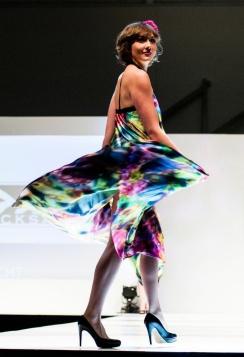 Finishing touches: make-up, hair, and accessories
Finishing touches: make-up, hair, and accessories
Accentuating outfits is no small feat. To really pull together an outfit a variety of people and organizations are required, and not just the designers.
Hair and make-up were an effort somewhat on part of the students, but largely on the part of volunteers and students from Utopia Academy and the Blanche MacDonald Centre.
For the photo shoot and fashion show, hair stylists and makeup artists are given images that show them what the designers are looking for. They haven’t seen the designs before, so they do their best to follow the designs and make them work.
Karishma Ram, a volunteer with the Blanche Macdonald Centre, described the wide variety of makeup styles.
“We’ve got someone here doing safari theme, we have someone who’s doing very neutral brown smoky eyes. It really just depends on the designer and what they’re looking for. We’re adding gems to someone’s eyes later on just because part of her outfit is having gems along her eyes,” Ram said.
The designer Matthew Gonzales wanted his “Ivy League dandies” to hold some classic gangster charm. He asked for dark makeup around his models’ eyes, hoping to create what he calls the look of a “classy corpse.”
While Gonzales’ accessories came from his own personal collection of hats, not all student accessories did. Instructors collect a lot of accessories which students can choose from to add to their designs. On the day of the photo shoot, shoes and hats were lined up as models came out of the dressing rooms. The instructors, Deanna Devitt and Bev Fanzega threw out accessory suggestions as the models went off for their photos.
Berlinghoff still wasn’t quite certain about accessories for one of her designs after the photo shoot.
“My [model is] wearing like super-short hot pants. What shoes do you wear with super-short hot pants?” she laughed, exasperated. “I don’t know. I’ve never worn them. It’s hard. I think she’s going to wear high socks.”
By the show she had decided on dark tights, with wild hair and hip high heels to emphasize her modern street-wear look.
After the show the recent fashion graduates lingered, chatting with friends and family. Ning Hao, recipient of the textiles award and finalist of the Télio’s 2013 Canada’s Breakthrough Designers competition, was emotional. Berlinghoff was excited, happy to be completed with the program, and already lining up an internship and a potential job. Other students, like Raines, were a tad uncertain, still a little taken aback that all their hard work was completed for the time being.
As the crowds left the building and the voices began to die down, it was not just the images that stayed with me, but the indomitable spirit of the 11 graduating fashion students.
With an initial 25 students in the program, they were the 11 who had stuck it out, and the results were stunning. Not just in the designs, but also in what they seemed to take away from the program.
“The one thing this program teaches you [is] a work ethic like no other. You learn to soak hours and hours of your life into something. It gives you a good perspective [and] skills you can carry on to other facets of your life that aren’t fashion related,” graduate Ecklebrecht said, reflecting on her experience. “You don’t see [it] on the outside, you see a fashion show. You don’t see a work ethic that’s been taught, [and it’s] one of the biggest things I’ve taken from this program.”


